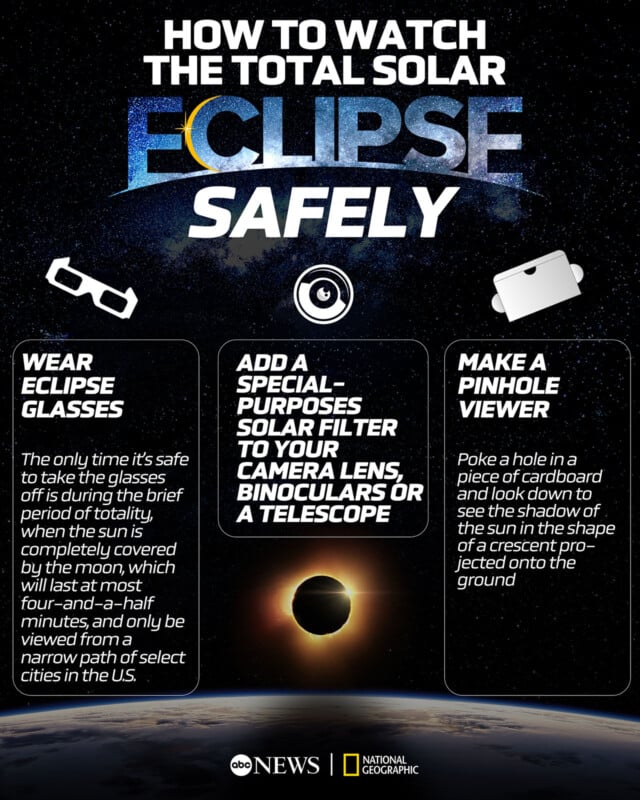Eclipse Across America: How to Photograph and Enjoy Today’s Historic Eclipse
![]()
After years of anticipation, the 2024 total solar eclipse has finally arrived. Many millions of Americans will be in or near the eclipse’s path of totality, ranging from Texas to Maine. However, hundreds of millions more people will have to find other ways to enjoy the celestial event. That’s where ABC News and National Geographic come in with Eclipse Across America.
Beginning today, April 8, at 2 PM EDT on ABC, ABC News Live, National Geographic Channel, Nat Geo WILD, Disney+, Hulu, and various social media platforms, ABC News’ David Muir and Linsey Davis will report live from Burlington, Vermont, chatting with many talented photographers and knowledge scientists throughout the eclipse’s path.
The featured photographers include Cristina Mittermeier, recently featured as part of Nat Geo’s new television series, Photographer, and acclaimed astrophotographer Babak Tafreshi, who PetaPixel chatted with last week to get some last-minute eclipse photography tips.
The broadcast will also feature eclipse photos from viewers throughout the country. People creating extraordinary images and videos can share them with the hashtag “#EclipseAcrossAmerica,” and Mittermeier will be curating the content live, sharing the best visuals live on air.
Astrophotographer Babak Tafreshi’s Eclipse Photography Tips
As for creating awesome photos, what does Tafreshi recommend? There are possibilities throughout the entire path of totality to get close-up shots of the eclipse using a telephoto lens, provided photographers have the appropriate filters.
“Many people are aiming to capture close-up, sharp, clean images of the solar corona. That’s very important, obviously, because we don’t have many images from the inner corona,” Tafreshi tells PetaPixel.
A wide-angle lens is a better bet for photographers hoping to get more creative and capture a personal photo that puts their eclipse experience within a specific time and place.
Photographers hoping to achieve a composite image of the eclipse’s progress — a very challenging but achievable shot — Tafreshi has a lot of advice.
“You have a fixed tripod, and every couple of minutes, you’re doing one shot, or you can do more than one, but select an image from every two to five minutes. You then have the sequence of multiple exposures of all the phases of the Sun.”
You must keep a solar filter on your lens for these sequence shots of the partial eclipse. The images will be very dark, save for the crescent Sun.

During the total eclipse, the photographer can remove the filter, change their exposure for totality, and shoot away. This is the grounding shot for the composite, where photographers can place their partial eclipse shots of the Sun. As soon as the totality ends, pop the filter back on and catch the back end of the partial eclipse sequence.
But be prepared to be very patient. “That’s like a three-hour sequence,” Tafreshi warns. “But it gives you plenty of options in creativity.”
Preparation is vital, although, of course, preparation time is running out. But for photographers shooting their first eclipse, Tafreshi has some other advice.
“Definitely use a tripod,” he says, suggesting that the experience will be overwhelming, even for seasoned eclipse viewers. “Controlling your emotions is very important. Otherwise, your hands start to shake.”
Tafreshi, who has photographed 13 eclipses, still finds it challenging to keep his hands steady during the experience. By the time, this time around, he is working on a project concerning how animals behave during the eclipse, particularly totality.
So, for photographers planning to venture out today, bring your tripod, take deep breaths, and most importantly, enjoy the moment. For everyone else, tune in to Eclipse Across America, beginning at 2 PM EDT on ABC, National Geographic, Hulu, and Disney+ networks and streaming services.
Image credits: National Geographic, ABC